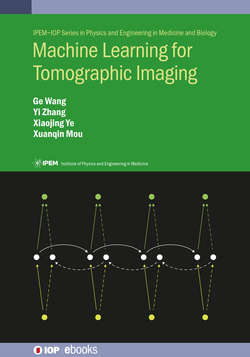Читать книгу Machine Learning for Tomographic Imaging - Professor Ge Wang - Страница 35
2.3.2.2 Experimental results
ОглавлениеThe dictionary learning algorithms produced quite exciting image reconstructions from low-dose data. Compared to the traditional regularizers widely used for CT reconstruction, the dictionary learning results are superior in terms of edge preservation and noise suppression. Under few views and/or low-dose conditions, the dictionary learning framework performed very well, with two examples shown in figures 2.6 and 2.7.
Figure 2.6. Reconstructed images from a low-dose sinogram collected in a sheep lung CT perfusion study. The upper row shows the images reconstructed using the FBP, GDSIR, ADSIR, TVSIR, and GDNSIR methods (from left to right), respectively. The magnified local regions are shown below the FBP result (upper left, upper right, lower left, and lower right correspond to GDSIR, ADSIR, TVSIR, and GDNSIR, respectively). The display window is [−700,800] HU. The second to fifth images in the bottom row are the difference images between the FBP image and the results obtained using the GDSIR, ADSIR, TVSIR, and GDNSIR methods, respectively, in the display window [−556,556] HU. Reproduced with permission from Xu et al (2012). Copyright 2012 IEEE.
In addition to using the sheep dictionary to reconstruct images of the same sheep, Xu et al also used this sheep dictionary to reconstruct human chest CT images. Excitingly, the global dictionary trained from images of the sheep performed well in the case of human chest scans, which implies that CT images have similar low-level structural information just as natural images. In fact, the dictionary learning approach can transfer natural image statistics for medical image reconstruction, which has a profound impact on tomographic imaging in general (Xu et al 2012).
Figure 2.7. Reconstruction results using the FBP, GDSIR, and ADSIR methods, respectively (from top to bottom), with the left and right columns representing the results from 1100 and 550 projection views, respectively, in the display window [0,2]. Reprinted with permission from Xu et al (2012). Copyright 2012 IEEE.
The proposed L0-norm-based dictionary learning method is highly nonconvex and computationally nontrivial, although pilot results were reported through L0-norm-based dictionary learning. Motivated by this challenge, an algorithm for low-dose CT via L1-norm-based dictionary learning should be popular to avoid non-convexity. It has been verified that the L1-norm-based sparse constraint has a similar performance as that of GDSIR and ADSIR (Mou et al 2014).
